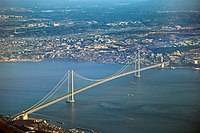
Photo from wikipedia
Long-span suspension bridges are susceptible to wind loads due to their lightweight, low stiffness, and small structural damping. Recently, two large-span suspension bridges in China that closed for several months… Click to show full abstract
Long-span suspension bridges are susceptible to wind loads due to their lightweight, low stiffness, and small structural damping. Recently, two large-span suspension bridges in China that closed for several months due to COVID-2019 experienced large-scale and continuous vortex-induced vibration shortly after reopening to traffic, and the traffic was closed again for safety consideration, which has aroused widespread concerns in society. To provide a reference for owners and related decision-making departments whether to restore the traffic, this article intends to explore the impact mechanism of traffic loads on the dynamic behavior of suspension bridges. First, two mechanical models for suspension bridges considering traffic loads and structural damping are proposed in this article. Then, based on the extended dynamic stiffness method, the explicit expressions of modal damping ratio in the two models are derived for the first time. Subsequently, Wittrick–Williams algorithm is employed to solve the frequency equation to obtain the modal frequency of the structure that considers the effect of traffic loads. A numerical case is studied to inspect the influence of traffic loads on the structural dynamic characteristics. Moreover, field monitoring data of accelerations of a suspension bridge are utilized to demonstrate the reasonability and accuracy of the approach proposed. Analysis shows that the theoretical results are consistent well with the measured ones, which indicates the traffic loads will affect the dynamic characteristics of the suspension bridge, thus reducing the modal frequency and increasing the modal damping ratio. Besides, the measured results further explain that the contribution of traffic loads to the structural damping is significant, which has a positive effect on preventing and eliminating vortex-induced vibration response. Some interesting and enlightening conclusions are also obtained in this article.
Journal Title: Structural Health Monitoring
Year Published: 2021
Link to full text (if available)
Share on Social Media: Sign Up to like & get
recommendations!